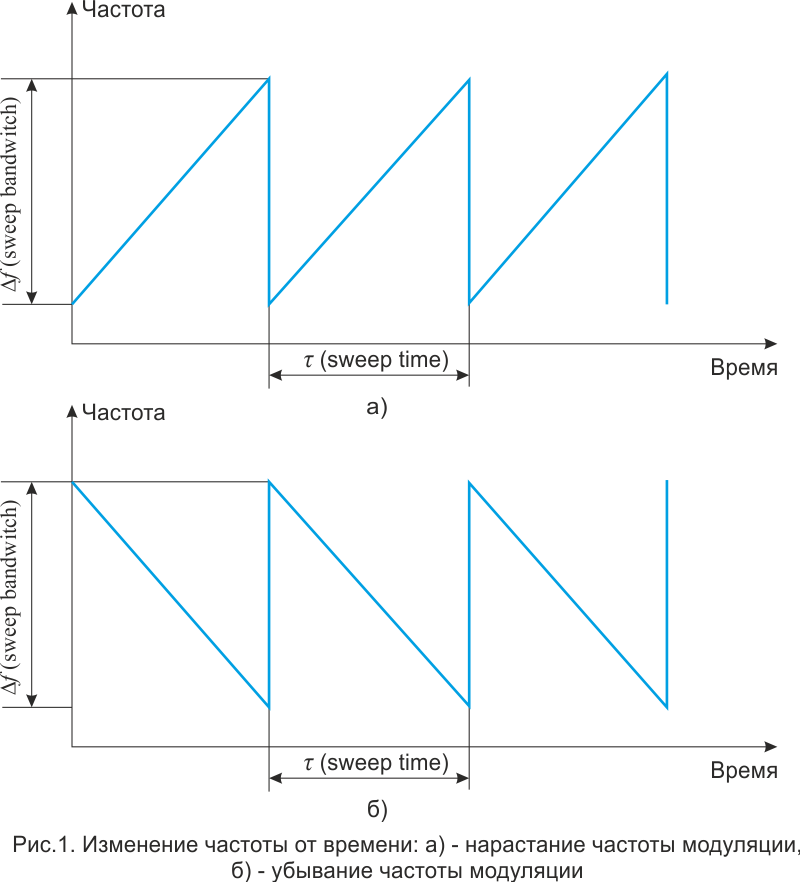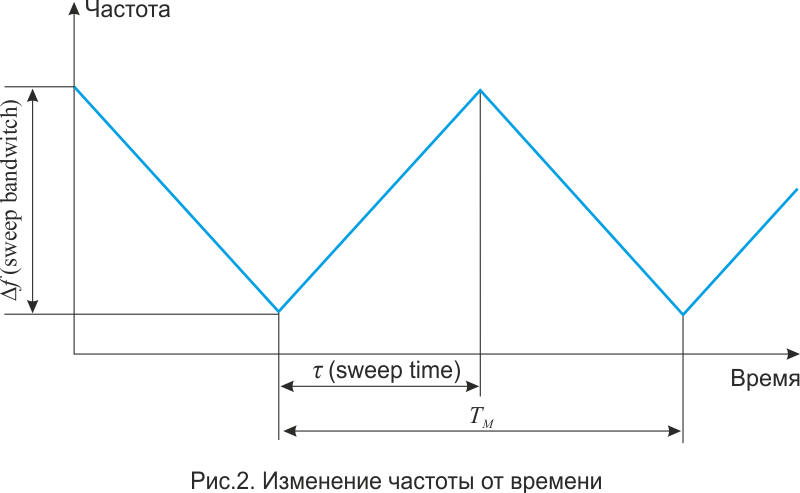FMCW Waveform
Frequency-modulated continuous radiation generator (FMCW).
blockType: FMCWWaveform
|
Path in the library: |
Description
Block FMCW Waveform generates a frequency-modulated continuous radiation (FMCW) signal with a preset frequency increment time and frequency deviation . The output signal of the unit is an integer number of pulses or a sequence of samples.
Ports
Output
Port_1 is a continuous radiation signal with frequency modulation
complex column vector
The output of the block, defined as a complex column vector containing signal samples. The number of samples in the signal depends on the following parameters:
-
If the Output signal format parameter is set to
Samples, the output of the block is determined by the Number of samples in output parameter or the number of samples. -
If the Output signal format parameter is set to
Sweeps, the output of the block is determined by the Number of sweeps in output parameter or the number of frequency-modulated pulses. -
If the Sweep direction parameter is set to
Triangle, then the signal modulation period is twice as long as the frequency increment time.
Parameters
Sample rate (Hz) — pass sampling rate:q[<br>] 1e6 (default) | positive scalar
The sampling frequency of the signal in the form of a positive scalar. The units of measurement are Hz.
Product of the sampling rate Sample rate (Hz) and frequency increment time Sweep time must be an integer.
Block parameter |
|
Values |
|
By default |
|
Sweep time (s) — period of the FM pass simulation signal:q[<br>] 1e-4 s (default)
Frequency increment time (Sweep time) is a scalar or vector string of positive real numbers and can characterize both the increase in the frequency of signal modulation and its decrease. The units of measurement are seconds. The product of the sampling rate (Sample rate) and the frequency increment time must be an integer.
So that the frequency increment time is changed in the output signal, set the parameter Sweep time as a vector string. The signal generator sequentially takes the corresponding vector value as the frequency increment time for its modulation period . When the last value of the vector is reached, the process continues from the beginning.
If the parameter Sweep direction is set to Up or Down, then the signal modulation period is is equal to the frequency increment time . If the parameter Sweep direction is set to Triangle, then the signal modulation period is twice the frequency increment time , since each period of signal modulation consists of a time of increasing frequency increment and decreasing frequency deviation.
If the parameter Sweep time and the parameter Sweep bandwidth are vector strings, then their dimension must match.
Block parameter |
|
Values |
|
By default |
|
Sweep bandwidth (Hz) — pass frequency deviation:q[<br>] 1e5 Hz (default)
Frequency deviation a linear frequency modulated signal in the form of a scalar or a vector string of positive real numbers. The units of measurement are Hz.
To frequency deviation changed in the output signal, set the parameter Sweep bandwidth as a vector string. The signal generator sequentially uses the corresponding vector value as the frequency deviation for its modulation period. When the last value of the vector is reached, the process continues from the beginning.
If the Sweep time and Sweep bandwidth parameters are vector strings, then their dimension must match.
Block parameter |
|
Values |
|
By default |
|
Sweep direction — direction of frequency deviation
Up (default) | Down | Triangle
Direction of frequency deviation:
-
Up— frequency increase (Fig. 1a). -
`Down' — frequency reduction (Fig. 1b).
-
`Triangle' is a sequential increase and decrease in frequency (Fig. 2).


Sweep interval — position of the pass modulation interval:q[<br>] Positive (default) | Symmetric
Frequency deviation interval, set as Positive or Symmetrical:
-
Positive— the frequency of the signal will vary in the range from0toB, whereBis the value of the Sweep bandwidth parameter. -
Symmetrical— the frequency of the signal will vary between−B/2and `B/2'.
Output signal format — pass output signal format:q[<br>] Sweeps (default) | Samples
The output signal format, set as:
-
`Sweeps' is the output signal of the block, which has the form of several frequency-modulated pulses, the number of which is determined by the parameter Number of sweeps in output.
-
Samplesis the output signal of the block, which has the form of a sequence of samples, the number of which is determined by the parameter Number of samples in output.
If the Sweep direction parameter is set to Triangle, then the frequency increment time is It is half the period of the signal modulation. .
Number of samples in output — number of samples of the pass output signal:q[<br>] 100 (default) | positive number
The number of samples of the output signal, set as a positive integer.
Example: 1000
Dependencies
To use this parameter, set the Output signal format parameter to Samples.
Block parameter |
|
Values |
|
By default |
|
Number of sweeps in output — number of pulses of the pass output signal:q[<br>] 1 (default) | positive integer
The number of frequency-modulated pulses of the output signal, specified as a positive integer.
Dependencies
To use this parameter, set the Output signal format parameter to Sweeps.
Block parameter |
|
Values |
|
By default |
|
